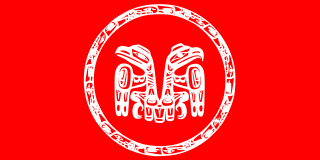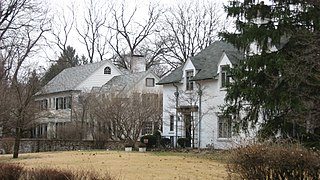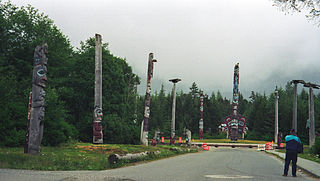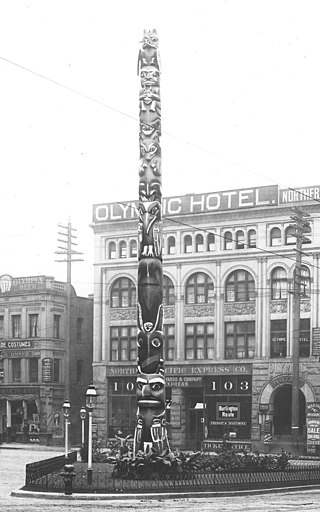
The Haida are an Indigenous group who have traditionally occupied Haida Gwaii, an archipelago just off the coast of British Columbia, Canada, for at least 12,500 years.

Totem poles are monumental carvings found in western Canada and the northwestern United States. They are a type of Northwest Coast art, consisting of poles, posts or pillars, carved with symbols or figures. They are usually made from large trees, mostly western red cedar, by First Nations and Indigenous peoples of the Pacific Northwest Coast including northern Northwest Coast Haida, Tlingit, and Tsimshian communities in Southeast Alaska and British Columbia, Kwakwaka'wakw and Nuu-chah-nulth communities in southern British Columbia, and the Coast Salish communities in Washington and British Columbia.

Ketchikan is a city in and the borough seat of the Ketchikan Gateway Borough on Revillagigedo Island of Alaska. It is the state's southeasternmost major settlement. Downtown Ketchikan is a National Historic Landmark District.
Hydaburg is a first-class city in the Prince of Wales-Hyder Census Area, in the U.S. state of Alaska. The population was 382 at the 2000 census and 376 as of the 2010 census. The name "Hydaburg" refers to the Haida people.

Kasaan is a city in the Prince of Wales-Hyder Census Area in the U.S. state of Alaska. The population was 49 at the 2010 census, up from 39 in 2000. The name "Kasaan" comes from Tlingit Kasa'aan, meaning "pretty town".

Klawock is a city in Prince of Wales–Hyder Census Area, in the U.S. state of Alaska, on the west coast of Prince of Wales Island, on Klawock Inlet, across from Klawock Island. The population was 755 at the 2010 census, down from 854 in 2000. It is located 90 kilometres (56 mi) from Ketchikan, 11 kilometres (6.8 mi) from Craig, and 39 kilometres (24 mi) from Hollis.

Prince of Wales Island is one of the islands of the Alexander Archipelago in the Alaska Panhandle. It is the fourth-largest island in the United States and the 97th-largest island in the world.

Sitka National Historical Park is a national historical park in Sitka in the U.S. state of Alaska. It was redesignated as a national historical park from its previous status as national monument on October 18, 1972. The park in its various forms has sought to commemorate the Tlingit and Russian experiences in Alaska.

The Alaska Governor's Mansion, located at 716 Calhoun Avenue in Juneau, Alaska, United States, is the official residence of the governor of Alaska, the first spouse of Alaska, and their families. It was designed by James Knox Taylor. The Governor's Mansion was first occupied in 1912 by Territorial Governor Walter Eli Clark.

Golden Hill is an affluent and historic neighborhood overlooking the White River on the west side of Indianapolis's Center Township, in Marion County, Indiana. The district is bounded on the east by Clifton Street, which is west of Martin Luther King Jr. Boulevard ; on the west by the White River and the Central Canal; on the south by Thirty-sixth Street; and on the north by Woodstock Country Club, immediately south of Thirty-eighth Street. Golden Hill is noted for its collection of homes designed by several of the city's prominent architects. The estate homes reflect several styles of period revival architecture. The district is known as for its community planning and remains an exclusive enclave for the city's prominent families. Golden Hill was added to the National Register of Historic Places in 1991.

The Kake Cannery is a historic fish processing facility near Kake, Alaska. Operated by a variety of companies between 1912 and 1977, the cannery was one of many which operated in Southeast Alaska, an area historically rich in salmon. The cannery's surviving buildings are among the best-preserved of the period, and provide a window into the labor practices of the cannery operators, which emphasized production over working conditions, and made significant use of immigrant contract workers. It was declared a National Historic Landmark in 1997.

Cordova Bay is a bay in the Alexander Archipelago of southeast Alaska. It opens onto Dixon Entrance to the south, between Cape Muzon on Dall Island and Point Marsh. The name Puerto Cordova y Cordova was given by the Spanish explorer Lieutenant Don Jacinto Caamaño in 1792, in honor of Admiral Luis de Córdova y Córdova. The name was published by George Vancouver in 1798.

Totem Bight State Historical Park is a 33-acre (13 ha) state park in the U.S. state of Alaska. It is located north of Ketchikan.

Linn Argyle Forrest, Sr. (1905–1987) was an American architect of Juneau, Alaska who worked to restore "authentic Southeast Alaska Native architecture, especially totem poles". During the 1930s and the Great Depression, he oversaw Civilian Conservation Corps programs of the New Deal to preserve totem poles and other aspects of traditional, native architecture. In conjunction with a $24,000 U.S. grant to the Alaska Native Brotherhood as a CCC project, Forrest oversaw the construction of the Shakes Island Community House and totems at Wrangell, Alaska during 1937–1939. Drawing on this experience, he later wrote The Wolf and the Raven: Totem Poles of Southeastern Alaska, which has been printed in 20 editions.

The Totem Heritage Center is a historical and cultural museum founded in 1976 and located in Ketchikan, Alaska. The center is operated by the city of Ketchikan.

The Chief Shakes Historic Site is a historic collection of original and recreated Native Alaskan artifacts. It is located on Shakes Island, inside Wrangell Harbor, Wrangell City and Borough, Alaska. The most prominent feature of the site is a 1940 reconstruction of a Tlingit community house. This structure incorporates six original house posts, carved poles similar to totem poles. The house posts, four of which are from the community house of Chief Shakes, a line of like-named Tlingit clan leaders, are reported to be among the oldest known to survive. The house is surrounded by seven totem poles, two of which are original Tlingit work, and five of which are copies created by crews of the Civilian Conservation Corps that also built the house.

The Chief Son-I-Hat's Whale House and Totems Historic District, also known as the New Kasaan Totem Pole Park, is a historic district encompassing the relocated remnants of Old Kasaan, a historic village of the Haida people in Prince of Wales–Hyder Census Area, Alaska. Now located in new Kasaan, the property includes the c. 1880 clan house of Chief Son-I-Hat, the Haida leader who oversaw the relocation of the people from Old to New Kasaan, and a totem pole he moved. In the 1930s, crews from the Civilian Conservation Corps relocated and/or replicated additional totem poles at the house site, restored the house, constructed a small park, and cut a trail from the center of new Kasaan to the park and adjacent cemeteries.

Saxman Totem Park is a public park in the city of Saxman, Alaska, just south of Ketchikan in southeastern Alaska. The park is home to a collection of totem poles, some of which are old poles relocated to this place from unoccupied Tlingit villages in the region, or were reconstructed by skilled Tlingit carvers under the auspices of the Civilian Conservation Corps in the 1930s. The poles originated in the communities of Old Tongass, Cat Island, Village Island, Pennock Island, and Fox Village. One of the carved items recovered from unoccupied villages is a marble statue of a grizzly bear. The park was listed on the National Register of Historic Places in 1979.
Chief John Wallace (Haida) was a Haida people master carver who was commissioned in 1931 by the US Department of the Interior to carve two, 8-foot totem poles, "The Raven" and "The Chief's Daughter." These are in the collection of the Interior Museum. He also worked in Hydaburg Totem Park in the Tongass National Forest, Alaska.

The Pioneer Square totem pole, also referred to as the Seattle totem pole and historically as the Chief-of-All-Women pole, is a Tlingit totem pole located in Pioneer Square in downtown Seattle, Washington.




















